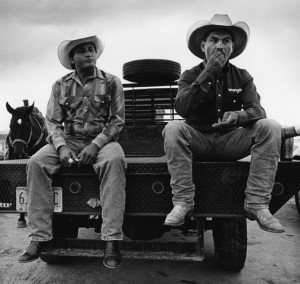
Rodeo, San Juan Pueblo, by Sam Adams, 1996-2005. Palace of the Governors Photo Archives, Photo Legacy Project.
An ad aimed at kids may well have changed Sam Adams life. “When I was a little boy, we used to read comic books,” he said, “and at the back were a series of advertisements for all sorts of weird things, like whoopee cushions, magic kits, things that kids would enjoy getting their hands on. And one of those was for a Candid camera, which cost three or four dollars at that time.”
Adams bit and began snapping pics at age 9. Today, he’s a retired motion-picture and television literary agent who moved to Santa Fe in 1989 and turned his attention full-time to photography.
“In the beginning it wasn’t really about the photography, it was more about the equipment, and then it became more about the subjects as time went on.”
In 2005, he won the New Mexico Council on Photography’s Eliot Porter Award. His work has been exhibited at regional museums and, most recently, took over the Meem Community Room, where we’ll host a small reception for Photography of Sam Adams, from 5–7 pm on Friday, August 7.
The exhibit honors Adams’ donation of his life’s work to the Photo Legacy Project, the Palace of the Governors Photo Archives’ effort to boost its ranks of contemporary shooters.
“In 2012 we worked with Sam to get these images, which date from 1957 to 2012. There are tons of boxes of original prints and negatives that were taken all over the world, mostly of individuals or groups of people,” Kosharek said. “Sam was one of the original folks to donate to the archives’ Photo Legacy Project. He was one of the pioneers of Photo Legacy.”
Choosing film over digital formats, Adams has produced thousands of black-and-white pictures and makes gelatin silver prints of images captured around the world. He jealously guards his amateur status and remains deeply rooted in the 20th and not the 21st century.
“This collection spans a period of 50 years, and there are almost no landscapes,” he said. “The focus became on the people and what they were doing. You change your viewpoint over the years. Pictures I once liked, I don’t like them so much anymore, and there are images on proof sheets that very well could have been prints for this exhibition.”
